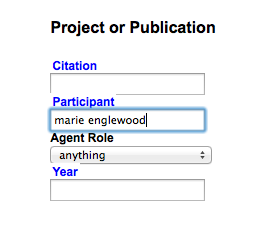As of November 2011, Arctos has undergone major surgery in how Publications are created.
First, some history:
“Formatted Publications” were dynamically created by concatenating publication information (such as title and page numbers) together with Agent Names. Along with requiring information that was not useful for locating specimens (“show me specimens published on page 32….”), this often required the creation of new agents and/or agent names. This was a lot of work for little or no return, and often improperly used anyway. A trigger used some very complex logic to pull all this together into a “proper” citation, and when that failed (e.g., due to nonstandard page numbering) you were just out of luck. We learned a lot from this structure, but it never felt quite right.
Now, the current situation by way of example. (I’m making up the details; only the publication is real. Apologies to the people whose personal details I am going to get entirely wrong.) Let’s say there’s been a loan of (very) old moth specimens to Maria E. McNamara and her graduate student Derek E. G. Briggs. This (theoretical) loan results in a (real) publication – Fossilized Biophotonic Nanostructures Reveal the Original Colors of 47-Million-Year-Old Moths. The publication includes additional authors who are not in Arctos, were not part of the loan, and who are not important to demonstrating the usefulness of our collections.
There is a DOI given in the publication. Copy that, open the “create publication” form in Arctos. Paste the DOI (10.1371/journal.pbio.1001200) excluding any prefix (“doi:” and “http://dx.doi.org/” are common) into the appropriate box, and click “[ crossref ].”
The DOI lookup service was able to obtain metadata, and everything you see above is the result of that one click. If you click “create publication” at this point, you would create a usable publication to which Citations could be attached, and which could be a part of Projects.
Here, however, we wish to capture agent information for at least the two authors to whom we’ve made our earlier (fake) loan. During the crossref lookup, Arctos has first looked for agents who match the string provided by DOI, then for agents who MIGHT match the string provided by DOI. All names – not just preferred – are considered. A maximum of 5 “suggestions” are returned for each of the first 5 authors.
The first agent returned by the DOI service is Maria E. McNamara. There is no agent with the exact name “Maria E. McNamara” in Arctos, but there are 3 agents with last name “McNamara,” all suggested in the first line of the blue Agents grid. We happen to know that “Marie Englewood McNamara” is correct, so we click that entry to select her.
The second author, who we also care about because he was on the loan, is “Derek E. G. Briggs.” Derek is also a pre-existing Arctos agent, and that agent happens to have an exact-match agent string available. Arctos finds and suggests only this agent, and again one click is all that’s necessary to add him to the publication.
The third author, Patrick J. Orr, does not have an exact name match in Arctos, and does not have a last name match in Arctos, so the system has gone off looking for agents with any string matching “Orr.” In this case, the results are not useful and can simply be ignored. If Patrick J. were deemed important, he would need to be added and selected in the standard way. If there were 6 “Orr” agents, Patrick J. might still not show up in the suggest list, but could be found in the standard way of picking agents. Take-home message: The agent suggestions are just suggestions. Sometimes they’re useful, and sometimes they’re not. Make no assumptions from them.
If we select the two suggested agents and create the publication….
we can then locate it by any name of either of two the authors who we added
or anything from the “full citation”
including the authors that we did not explicitly include
but we can NOT find the publication by authors (as “Participants”) that we did not include
results in
We could have used PMID (PubMed ID) rather than DOI to roughly the same affect. Note that PMID and DOI are apparently independently created and do not return the same values (“Maria E. McNamara” vs. “Maria E McNamara,” etc.).
Formatting from either source is occasionally horrible, and you are encouraged to use the formatting tools provided (or your method of choice) to rid citations of things like ALL CAPS and missing or excessive punctuation.
Most of the time, using DOI or PMID will create better (as in fewer mistakes) publications with much less work than traditional means. The service is, however, not magic and you, the operator, are responsible for the results. Your collections may have additional guidelines as to what agents to include, or how to format publications.









